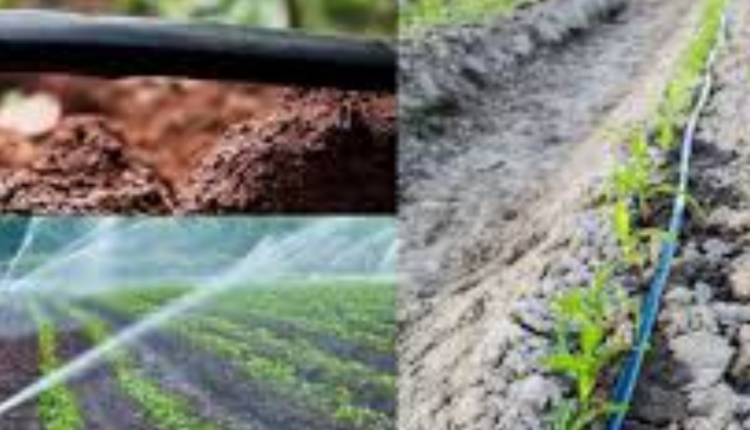Drip Irrigation System: Adopt Drip Irrigation System to reduce cost and increase income in farming
The best irrigation technique is drip irrigation. This reduces the cost of water, fertilizer, insect and weed killer and weeding
Drip Irrigation System: Three activities like irrigation, fertilizing and hoeing-weeding account for a major part of the cost of cultivation. Therefore, if its cost can be reduced, then the income of the farmers can increase significantly. For all these three tasks, the drip irrigation method or drip irrigation system, which gives water drop by drop to the plants in the field, is excellent, because it saves 30 to 60 percent of water and 30 to 45 percent of chemical fertilizers.
According to agricultural experts, since drip irrigation water is given directly near the roots of the plants, unnecessary weeds do not grow in the surrounding dry soil and only the plants use the nutrients of the soil. Thus, drip irrigation results in higher quality yields with higher market prices. This technique proves to be excellent for those fields which are known to be arid and semi-arid.
While the benefit of drip irrigation method can be taken in crops like cotton, sugarcane, maize, groundnut, rose and tuberose etc., it proves to be unmatched in the horticulture of fruits and vegetables. Because the cultivation of fruits and vegetables requires more and regular irrigation as compared to cereals and other cash crops. Drip irrigation for long duration crops such as apple, grapes, orange, lime, banana, guava, mulberry, date, pomegranate, coconut, plum, mango etc. Apart from tomato, brinjal, cucumber, gourd, pumpkin, cauliflower, cabbage, okra, it also proves to be very useful for the cultivation of vegetables like potatoes and onions.
What is drip irrigation method?
This technique of watering the roots of plants only according to the need was discovered in the 1960s in Israel, but soon it became very popular all over the world and especially in the countries facing water scarcity, especially in the Gulf countries. In drip irrigation, water is delivered slowly to the root zone of plants in the form of continuous drops through a network of thin pipes. In this, water evaporation and its consumption are also minimal. By this method, the nutrients of the compost also reach the exact place by dissolving in the water.
Advantages of Drip Irrigation Method
Less water, more yield : With drip irrigation, trees and plants get the required amount of water. Due to this, they remain stress-free and save 30 to 60 percent water as compared to other traditional methods of irrigation and due to the right proportion of water, the yield increases by 20 to 50 percent.
Soil: Drip irrigation can be used for cultivation in stony, undulating, barren and dry land, alkaline and seaside soil with low water seepage and scanty rainfall.
Saving of chemical fertilizers: Through drip method, chemical fertilizers are also dissolved in water and sent directly to the roots of plants so that the nutrients reach only the required trees and plants. This increases the yield on one hand and on the other hand saves up to 30 to 45 percent of chemical fertilizers.
Weed Control: In drip irrigation fields, the soil around the plants where weeds want to grow is dry but they do not get the required nutrients and moisture from dry soil. Due to non-growth of weeds, the labour of hoeing and weeding and the cost of weedicide is saved.
Pest and Disease Control: Drip irrigation leads to healthy and proper growth of plants and trees. This also gives them greater ability to resist pests and diseases. This also reduces the cost of pesticides.
Use of polluted water: Drip irrigation method can be made extremely useful even for those areas where clean and suitable water is not available. In such places, polluted water can be filtered and used for irrigation.
Working of Drip Irrigation Method
Drip irrigation method is made automatic by installing sensors that control the level of soil moisture. To this end, a network of traditional drip irrigation devices – irrigation controllers, motor relays and solenoid valves is combined with an ever-tracking soil moisture sensor. This sensor is buried in the soil near the root of the plant in the field.
The solenoid valves in the middle of the pipe going to the fields open and close according to the signals received from the sensor to the controller. In drip irrigation method, according to the water requirement of different crops, according to the setting done in the controller, the speed of dripping of drops can be increased or stopped. This allows the leaves of the plants to make more of their own food and increases the yield.
Drip irrigation equipment
The main equipment of a drip irrigation plant is named : header assembly, filters – hydrocyclones, sand and screen filters, chemical and fertilizer feeders – venturi, fertilizer tank, main line, submain line, valve, lateral row (polytube) and ammeter – OnRow / InRow / Mini Sprinklers / Jets.
Drip Irrigation Plant Care
Backwashing of the sand filter should be done daily after the pump is started and when the plant pressure is stable. Hydrocyclone Filters should be cleaned every 5-6 hours after initial cleaning or periodically depending on water quality.
After cleaning the filter, proper pressure should be controlled with the help of bypass valve of the header assembly. Water is available in the same quantity everywhere from the plant operating at suitable pressure.
Inspect the fields to see if there is any breakage or leakage in the pipe or if any pipe is bent or pressed. If so, fix it immediately.
Make sure that all the drippers of the drip plant get water properly and at the right place. Otherwise, take necessary measures to ensure that there is uniformity in the wetting of the ground.
Cost of drip irrigation method
The initial cost of adopting this best irrigation technology depends on the area in which it is to be installed, soil quality, sowing pattern, water quality and equipment quality, and for what crops is it to be used? For example, the cost of setting up a drip irrigation system for vegetable crops works out to around Rs 50 to 65 thousand per acre, while for fruit cultivation its cost can be around Rs. 35 to 40 thousand per acre. If good quality ISI marked equipment is used then it can work effectively for 7 to 10 years.
Government help for drip irrigation
Under the Pradhan Mantri Krishi Sinchai Yojana (PMKSY), the central government gives subsidy per beneficiary for setting up drip irrigation plants in an area of up to 5 hectares. The quantum of subsidy varies according to the categories of areas of the country like hilly, plain, desert, arid, coastal etc. To get more information about this, either visit the website of Pradhan Mantri Krishi Sinchayee Yojana https://pmksy.gov.in/ or contact your nearest agriculture office.
Contact us- If farmers want to share any valuable information or experiences related to farming, they can connect with us via phone or whatsApp at 9599273766 or you can write to us at [email protected]. Through Kisan of India, we will convey your message to the people, because we believe that if the farmers are advanced then the country is happy.
You can connect with Kisan of India on Facebook, Twitter, and WhatsApp and Subscribe to our YouTube channel.



